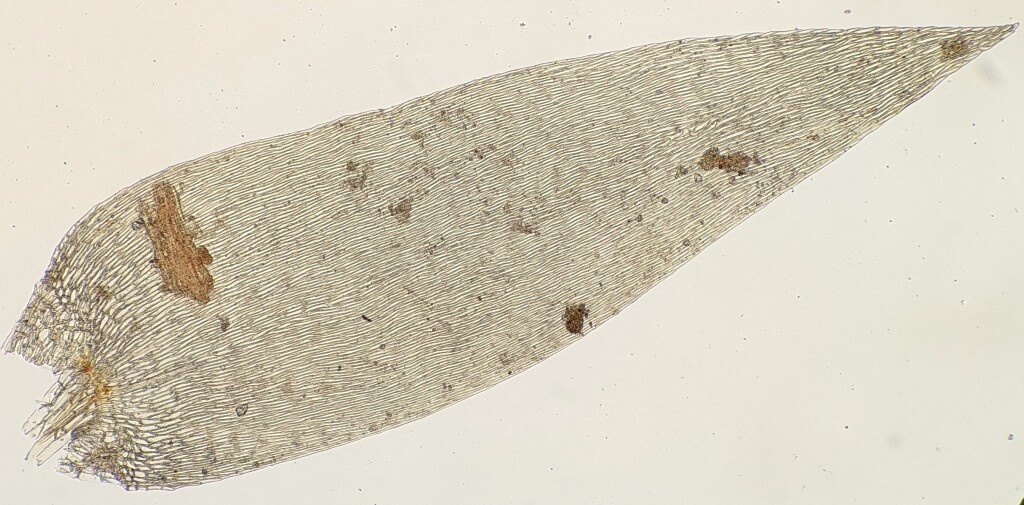Hypnaceae
Dioicous. Asexual propagules absent. Mats or tufts on soil, rocks, logs or tree bases. Stems creeping or ascending, rarely erect, regularly or irregularly pinnately branched, with rhizoids below leaf insertions; paraphyllia absent; pseudoparaphyllia subfilamentous to narrowly lanceolate; central strand present. Leaves arranged around stem and facing all directions or complanate, lanceolate to ovate, straight and erect-spreading to falcate-secund when moist, scarcely altered when dry, not plicate, those of branches slightly differentiated by being smaller, narrower and with less differentiated alar group; base not decurrent or auriculate; apex acuminate, without a hairpoint; costa short and double or indistinct; margin entire or serrulate, plane or recurved near base, without a border; laminal cells linear, smooth or prorate near apex (not in Victoria); alar cells numerous, usually in a clearly delimited group, subquadrate to rectangular, larger toward base, hyaline, yellow or brownish. Pleurocarpous. Seta smooth. Capsules erect or inclined, curved to straight (not in Victoria), exserted, operculate, with a caducous annulus. Calyptra cucullate, smooth, glabrous. Operculum conic to short-rostrate. Peristome double and alternate; exostome of 16 entire teeth; endostome of 16 segments, with a high basal membrane; cilia present or sometimes rudimentary (not in Victoria).
One genus on all continents except Antarctica, with seven species (Schlesak et al. 2018; Kučera et al. 2019); one species in Victoria.
Other genera previously included in Hypnaceae (e.g. Austrohondaella, Calliergonella, Ctenidium, and Isopterygiopsis) as well as most of the species previously included in Hypnum, are more closely related to other families in phylogenies of DNA sequences (Tsubota et al. 2002; Arikawa et al. 2008; Gardiner et al. 2005; Huttunen et al. 2012; Schlesak et al. 2018; Kučera et al. 2019). Consequently, Hypnaceae is now recognised in a drastically narrowed state that comprises only Hypnum and seven species, including the type species H. cupressiforme Hedw., that occurs in Victoria (Schlesak et al. 2018; Kučera et al. 2019).
 Spinning
SpinningArikawa, T.; Tsubota, H.; Deguchi, H.; Nishimura, N.; Higuchi, M. (2008). Phylogenetic analysis of the family Hypnaceae based on rbcL gene sequences, in Mohamed, H., Baki, B.B., Nasrulhaq-Boyce, A. & Lee, P.K.Y. (eds), Bryology in the New Millennium, pp. 215–225. University of Malaysia, Kuala Lumpur.
Gardiner, A.; Ignatov, M.; Huttunen, S.; Troitsky, A. (2005). On resurrection of the families Pseudoleskeaceae Schimp. And Pylaisiaceae Schimp. (Musci, Hypnales). Taxon 54: 651–663.
Huttunen, S. et al. (2012). Disentangling knots of rapid evolution: origin and diversification of the moss order Hypnales. Journal of Bryology 34: 187–211.
Kučera, J.; Kuznetsova, O.I.; Manukjanová, A.; Ignatov, M.S. (2019). A phylogenetic revision of the genus Hypnum: Toward completion. Taxon 68: 628–660.
Schlesak, S.; Hedenäs, L.; Nebel, M.; Quandt, D. (2018). Cleaning a taxonomic dustbin: placing the European Hypnum species in a phylogenetic context!. Bryophyte Diversity & Evolution 40: 37–54.
Tsubota, H.; Arikawa, H.; Akiyama, H.; Luna, E.D.; González, D.; Higuchi, M.; Deguchi, H. (2002). Molecular phylogeny of hypnobryalean mosses as inferred from a large-scale dataset of chloroplast rbcL, with special reference to the Hypnaceae and possibly related families. Hikobia 13: 645–665.

